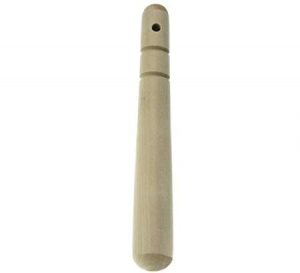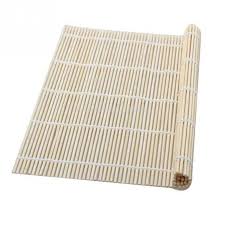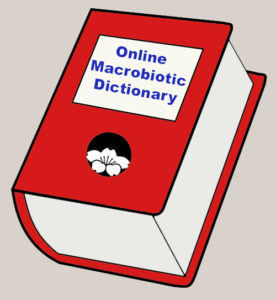
Completed Entries
Bean thread noodles.
Diced vegetables.
Residue from sake making.
Salad dressings add flavor and nutrition to salads and are used to balance more yin raw salads. Salt sources (more yang) used in dressings include sea salt, shoyu (soy sauce), miso, umeboshi, and umeboshi paste. Oils used in heated or unheated dressings include light sesame oil, toasted sesame oil, and olive oil, while oils like flax, avocado, or walnut oil are used unheated. Other ingredients commonly used in dressings are nut butters like almond butter or tahini; brown rice, umeboshi, or balsamic vinegar; lemon or lime juice; vegetables like avocado, onion, and scallions; and herbs and spices like garlic, oregano, granulated onion, dill weed, and powdered mustard.

Special tool (usually plastic) used to make pressed salads by the use of pressure. Also called a pickle press when used to make pickles.
Types of salads used in macrobiotic practice include pressed salads made with sea salt, shoyu, or another salt source; cooked salads using vegetables, whole grains, beans, noodles, and/or sea vegetables; raw tossed salads with or without dressing; and fruit salads. Pressed salads are vegetables mixed with less sea salt, shoyu (soy sauce), or other salty brine than when making pickles and are then pressed like pickles but stand for less time so they remain crunchy like salads. They are a great aid to digestion and are eaten at all times of the year and in all climates. Cooked salads, especially ones with whole grains, are often served as one-dish meals, especially in summer. In the early days of macrobiotics, raw salad was thought to be too yin for regular use, but rather to be eaten according to climate, season, and yin-yang factors. Currently more salad is included, especially in warmer climates and seasons or to balance yang foods or conditions. For example, a raw salad is often served with fish (or other animal food) or with a dressing including sea salt, shoyu, or other salt source. Fruit salads are most yin and have a cooling effect. Thus, they are eaten on occasion in hot seasons and climates.
Macrobiotics recommends using sea salt rather than commercial table salt for all consumption and cooking. In order of percentage, sea salt contains chloride, sodium, sulfate, magnesium, calcium, potassium, and a small amount of trace minerals. Sea salt is yang and alkaline forming. Table salt is highly processed and contains only chloride, sodium, and anticaking agents. It is still yang but less alkaline forming because the sulfate, magnesium, calcium, and potassium have been removed. Potassium iodide is added to table salt to make iodized salt and while potassium is alkaline forming, iodide is acid forming. Table salt (or the cheapest salt one can find) can be used for topical applications.
Water from warm bancha tea and salt used as a sponge bath for eye (or ear) problems.
See Cautionary note.
Water from warm bancha tea and salt used to flush/clear the nostrils or to stop nosebleeds.
See Cautionary note.
Salt water used at any comfortable temperature as a full bath to improve the kidneys, relieve pain, correct mineral imbalances, and other conditions.
See Cautionary note.
The amount of salt consumed is of vital importance for optimal health. Too little salt can lead to fatigue and dulled mental awareness and greater disorders if continued for a long period of time because salt is an alkalizing factor. Too much salt can lead to an attraction to sweets or other yin foods and to heart problems and high blood pressure if continued for a long time.
Roasted salt wrapped in cotton or placed in a cotton bag or sack and used to warm the body or on top of a plaster to help keep it warm.
See Cautionary note.
Cooled salt water used specifically for burns.
See Cautionary note.
Cold salted water used as a compress for extensive burns.
See Cautionary note.
Hot salt water used as a hip bath for female disorders.
See Cautionary note.
Saturated fats are one of three types of fatty acids, the others being monounsaturated and polyunsaturated. Saturated fatty acids have two hydrogen atom bonds to each carbon atom and are very stable. They are solid at room temperature. Saturated fats are found in animal-based foods, many baked goods and fried foods, and some plant-based oils, primarily coconut oil, palm oil, and palm kernel oil. Animal-based foods are also high in “bad” cholesterol (LDL, or high-density lipoproteins). The American Heart Association recommends limiting saturated fats to 5-to-6 percent because science has proven that an elevated “bad” cholesterol level leads to a higher risk for heart disease. A macrobiotic dietary approach aims for a dietary pattern with 2-to-3 percent saturated fats.
 A very yin condition indicated by white showing on three sides of the eyeball, especially below the eyeball. “One who has this eye is suspicious, fearful, insecure, quick to misunderstand, and passive. His heart, sexual organs, liver, kidney, and lungs are very sick.” Macrobiotics: An Invitation to Health and Happiness 7.
A very yin condition indicated by white showing on three sides of the eyeball, especially below the eyeball. “One who has this eye is suspicious, fearful, insecure, quick to misunderstand, and passive. His heart, sexual organs, liver, kidney, and lungs are very sick.” Macrobiotics: An Invitation to Health and Happiness 7.
Scallions chopped and passed under water.
Pencil-shaving style of vegetable cutting.
Sauces add flavor and nutrition to cooked grains, pastas, and vegetables. They also may be used to help balance one’s health condition. The base for most sauces used in macrobiotic practice are shoyu (soy sauce), miso, umeboshi, tofu, sesame or olive oil, nut or seed butters, kuzu or arrowroot, flour, and fruit. These sauces are usually made at home and most are cooked. Shoyu also is used as the main ingredient in dipping sauces. Macrobiotics recommends avoiding modern soy sauces that include refined sugar. Clear sauces that use kuzu or arrowroot as thickening agents are also popular.
The idea that one’s views are based on the quality and scope of one’s instruments of observation. Many scientific “truths” have been changed as instruments have improved (the splitting of the atom for example). The macrobiotic approach is to view life from the largest perspective possible; that is, including beyond the scope of scientific instruments.
Juice from chopped and ground scallions used as a drink for asthma attacks, uterine bleeding, or coughing up blood.
See Cautionary note.
Sea vegetables are high in minerals, fiber, and antioxidants and are an important addition to a grain-based diet. They are a good source for alkaline-forming minerals such as potassium, magnesium, calcium, sodium, and iron and are one of the best dietary sources of iodine (acid forming). Note: A significant amount of iodine is lost during excessive exposure to heat. Sea vegetables are used by themselves, usually in small amounts as condiments or side dishes, or cooked in soups, bean dishes, or desserts. They are often served or cooked with shoyu (soy sauce). Popular slightly yin sea vegetables in macrobiotic practice include nori, agar agar, Irish moss, dulse, sea palm, arame, kelp, alaria, and mekabu. Popular slightly yang sea vegetables include wakame and kombu. The macrobiotic recommendation is to buy undyed, untoasted, unchemicalized sea vegetables from a reputable source.
Seasonings spice up an otherwise “bland” diet, especially helpful for people transitioning to a macrobiotic approach. They are used in cooking and as garnishes for variety or as a complement to help balance the effects of some dishes; for example, grated daikon or grated radish is a good garnish for fish. Other yin seasonings used in macrobiotic practice include grated ginger, lemon or orange juice or zest, brown rice or umeboshi vinegar, green or yellow mustard paste, red or black pepper, garlic, basil, oregano, cinnamon, curry, cloves, vegetable oils, and other herbs and spices. Yang seasonings include gomashio (sesame salt), sea salt, miso, shoyu (soy sauce), and umeboshi plums or paste. Macrobiotics recommends using only natural spices and seasonings and avoiding artificial and chemicalized ones.
Secondary foods to principal foods (whole grains and their products) include fresh vegetables, beans, sea vegetables, fruit, nuts, seeds, fermented foods, fish, and teas.
Seeds are a great source of dietary fiber, healthy monounsaturated and polyunsaturated fats, and many vitamins, minerals, and antioxidants. They also have almost all amino acids and are a good protein complement to whole grains. Seeds are used mostly as snacks, in baking, as garnishes, or ground seed butter such as tahini (from hulled sesame seeds) or sesame butter (from whole sesame seeds). Smaller seeds contain less fat and are recommended most. In macrobiotic practice, seeds are considered yin alkaline forming and are usually roasted, especially when eaten as a snack or used as a garnish. Organic, undyed seeds are recommended. Popular seeds include sesame seeds, pumpkin seeds, sunflower seeds, squash seeds, and flax seeds.
The ability to critique one’s current physical and psychological condition and choose helpful foods and actions leading to greater health and self-development. In macrobiotic thinking, honest self-reflection is especially needed during times of disease in order to discover and counter the underlying cause. Other benefits include strengthening emotional stability by becoming clearer about one’s core values and, with daily contemplation, greater confidence in oneself and an increased understanding of the order of the universe.
The understanding that the small self (the ego or conscious mind that is temporal and short-lived) is only a receiver of commitments made by the universal (eternal) Self. “How clear you are in your understanding of the fact that you are but a part of the larger Self is the measure of your success or defeat. If your understanding is very clear you can overcome any difficulty. All difficulties, whether cancer or just an uncontrollable urge to eat ice cream, are rooted in one’s identifying with the small self and not the (big) Self.” Kaleidoscope, 212-213.
Wheat gluten that has been sautéed with fresh ginger and soy sauce.
Small Japanese snack crackers made from rice flour with seasonings.
Matchstick vegetable cutting—like julienne slicing.
The feeling of separation from the Infinite, the source of life and nourishment, is the greatest sickness. Life is a continuous spiral with no separation between animal-plant-elements-preatomic-energy-polarity-Oneness. The more this connection is realized, the greater the health.
A paste made by grinding roasted unhulled (whole) sesame seeds. Good for spreads, sauces, and dressings.
Oil extracted from sesame seeds. Sesame oil contains 87 percent unsaturated fats and is considered the most healthful oil by macrobiotic practitioners. Dark sesame oil is made by roasting the seeds before extracting the oil.
Seven laws or principles that form the basis for all laws of physical nature. These principles do not change and thus work in both the finite and infinite worlds. They may be used to resolve all conflicts by understanding that antagonisms are also complementary. The seven laws are:
- Inversion, Principle of: “What has a beginning has an end.” This principle negates the law of identity and contradiction in time. Individual life begins at birth and will end at some time. In a similar way, a sickness that begins one day will end in the future. This law is another way to say that everything in life changes over time. See Logic, Aristotelian.
- Front/Back, Principle of: “What has a front has a back.” This principle negates the law of identity and contradiction in space. Everything that exists has an opposite that is also complementary. The front is perceived as positive or useful while the back is perceived as negative or a shortcoming. An example is a medication (front) and its side effects (back). See Logic, Aristotelian.
- Difference, Principle of: “There is nothing identical.” This principle negates the law of identity. Even though there are countless stars in the universe and trillions of cells in one’s body, each is unique—for one thing, no two things can occupy the same space at the same time. See Logic, Aristotelian.
- Balance, Principle of: “The bigger the front, the bigger the back.” This principle negates the law of the excluded middle. This law is similar to the saying that something is too good to be true and the scientific principle that every action creates an equal and opposite reaction. An example is nuclear energy—a great front in the production of energy but a great back in terms of an accident or fallout. See Logic, Aristotelian.
- Nondual origin, Principle of: “Every antagonism is complementary.” This principle negates formal logic. All things are constantly in motion and thus changing due to the interplay of opposites. This law is another way of saying that everything changes and to look for both sides of every situation. See Logic, Aristotelian.
- Polarization, Principle of: “Yin and Yang are the classifications of all polarization. They are antagonistic and complementary.” This principle is the foundation of the universal dialectic logic. There is nothing that is complementary without antagonism. Yin and yang are the two arms of Oneness (Infinity) that create, sustain, destroy, and produce anew everything that exists in the finite world. Without conflict harmony has no meaning. Without contradiction there is no agreement.
- Polarizable Monism, Principle of: “Yin and Yang are the two arms of One (Infinity).” The unchanging, limitless, constant, and omnipotent world of Oneness produces and nourishes all things both physical and spiritual. Laws one through six are experienced by the five senses and may be analyzed by the mind or scientific instruments. In contrast, the seventh law is a sketch of the ultimate cause of the universe itself.
Seven definable stages or aspects of judgment (judging ability): physical, sensorial, sentimental, intellectual, social, ideological, and Supreme. Often referred to as “levels” with the higher ones (four through seven) being more valued than the lower ones (one through three). In reality all judging abilities are equally important for personal development.
- Physical: Decisions based on instinctive unconditioned reflexes and guided by hunger and thirst. This stage of judgment comes a few hours after birth and is also called instinctual, mechanical, or blind.
- Sensorial: Decisions based on what is pleasant or unpleasant, comfortable or uncomfortable. This judgment begins when one perceives differences such as cold and warmth. Eventually one can distinguish what is agreeable or disagreeable.
- Sentimental (Emotional): Decisions based on what is desirable and undesirable. This judgment first develops some months after birth as one learns what is helpful versus what frightens.
- Intellectual: Decisions based on conceptual, scientific thinking leading to knowledge, abstraction, and synthesis of concepts. In this stage one develops an ability to distinguish what is good or evil, useful or useless.
- Social: Decisions motivated by the desire for companionship with others and by the desire for approval from others. This stage includes two types of judgment: moral and economic.
- Ideological: Decisions based on a dialectical principle, religious thinking, or on the basis of justice and injustice. This judging ability is often used by an originator of ideas or other deep thinker. One’s choices in eating and drinking are based on following dietetic or religious principles.
- Supreme: Decisions based on the Order of the Universe, realizing the connection between all persons and things and thus embracing all phenomena, situations, and people in order to establish unification with Oneness.
Another name borrowed by Ohsawa for the Infinite, Infinity, or Oneness.
See Order of the Universe.
Type of large Japanese mushroom usually available in dried form. These mushrooms are helpful in reducing blood serum cholesterol but are usually expensive.
Japanese term meaning that the body and the land are not two (separated or divided). What we do to the environment directly affects us. Ignoring this fact leads to sickness and degeneration due to the lack of adaptation to one’s surroundings.
Spring chrysanthemum, an Oriental green vegetable. Watercress can be substituted.
Condiment made from kombu seaweed that has been cut into small pieces and cooked for a long time in soy sauce.
Cooked dishes with white sesame seeds or tofu added later. Shiro means white.
Leaves of the beefsteak plant—an iron-rich herb (iresine herbistii). Shiso is known as the beefsteak plant in the United States. Its seeds and leaves are used for their tangy flavor. The leaves are often pickled during the umeboshi-making process. Shiso powdered condiment is good in cases of anemia.
Beefsteak leaves that have been pickled, then dried and powdered.
Tea made from bancha tea and soy sauce.
Hot bancha tea and soy sauce used as a gargle for tonsillitis.
See Cautionary note.
Soy sauce.
These can be found in Asian and macrobiotic markets under the names chuba iriko and chirimen iriko and are similar to small, dried sardines. They can be roasted in a skillet with a little oil to prevent sticking and are eaten whole. If you have difficulty eating them whole, grind them and use them in soup or in gomashio as a condiment. They are very high in calcium and are a good source of vitamin B12.
In his day, prior to important medical knowledge about smoking—in particular its effect on the heart—Ohsawa classified tobacco smoking as yangizing and thus opposed to extreme yin cancers and believed smoking to be beneficial in some cases. However, the harmful effects of smoking tobacco far outweigh any benefit in terms of yin-yang.
Traditional Japanese buckwheat noodles.
Buckwheat flour and warm water made into a paste-like consistency and used for conditions of the bladder and surrounding areas.
See Cautionary note.
Sodium is a yang alkaline-forming mineral that is basic to good nutrition. All living beings need some amount of sodium. It conducts nerve impulses; contracts and relaxes muscle fibers in the heart, blood vessels, and elsewhere; maintains a proper fluid balance primarily between the bloodstream and intercellular fluids; and aids in the formation of digestive juices. Sodium also aids in the production of bile, which makes possible the assimilation of fat in the intestines. In macrobiotic thinking, sodium is the strongest alkaline-forming mineral and vegetables fermented with salt are an important part of a macrobiotic dietary approach. Sources of sodium in macrobiotic practice include natural sea salt; miso and shoyu; sea vegetables, especially dulse; green leafy vegetables; and sesame seeds. Animal foods contain a high amount of sodium and thus people eating large amounts of animal foods are advised to limit salt intake and to increase foods high in potassium.
Macrobiotic theory concentrates on the study of all minerals and, in particular, the proper balance of sodium (yang) and potassium (yin). All living things contain both sodium and potassium and the body is always balancing these two antagonistic yet complementary minerals. The origin of the importance of this ratio in macrobiotics comes from Japanese doctor Sagen Ishizuka around the end of the 19th century. He realized that potassium and sodium salts are antagonistic to each other in function, yet complementary. Potassium salt activates oxidation and sodium salt inhibits it. Potassium salt burns quickly, reducing heat and keeping one cool while sodium salt burns slower, increasing heat and keeping one warm. Ohsawa studied Ishizuka’s dietary theory for many years and changed potassium-sodium proportion to yin-yang proportion and named his philosophy “macrobiotics” with potassium as yin and sodium as yang. Ohsawa felt the ideal potassium-sodium ratio is around 5:1—a ratio over 5:1 is yin and a ratio under 5:1 is yang. For example, the potassium/sodium ratio of egg is 1:1, brown rice 5:1, and potato 512:1. Because macrobiotics emphasizes eating lots of potassium-rich vegetables (yin), these are balanced by yang cooking methods of heat, time, pressure, and salt.
Thin, round, white, or whole wheat noodles, often served cold in summer.
Soups add variety and nutrition to a grain-based diet. They can be simple or elaborate and cooked quickly or cooked a long time. Soups are soothing and relaxing. In macrobiotic practice, miso or shoyu (soy sauce) is often added at the end of cooking to most soups. Often, vegetables are sautéed for added flavor and are cooked in a specific yang-to-yin order based on the vegetables used and desired effect. Shorter cooking times and more yin vegetables have a yin effect while longer cooking times and more yang vegetables have a yang effect. Kombu and other sea vegetables are often included to add minerals and flavor. The most common daily soup in macrobiotic practice is miso soup with vegetables and sea vegetables.
Any variety of edible apple that is sour or tart to the taste, such as Granny Smith, Cortland, Newton, Pippen, and Jonathan. Sour apples are useful for diarrhea and for helping reduce children’s fevers.
Juice from grated sour apple used as a drink for diarrhea, slowing the pulse, or reducing a high fever.
See Cautionary note.
Soaked and mashed raw soybeans and flour made into a paste-like consistency and used for fevers, pain, or inflammation.
See Cautionary note.
Soy products are an important part of a grain-and-vegetable diet because soybeans are a complete protein, containing all essential amino acids. Thus they provide a reliable source of vegetable protein, fiber, and many vitamins and minerals that yield additional health benefits. However, soybeans also contain a trypsin inhibitor that reduces the body’s processing of proteins. Processed soyfoods like miso, shoyu (soy sauce), tempeh, and natto have the trypsin inhibitor removed and thus are highly used in macrobiotic practice. Soy milk and other soyfoods in which the trypsin inhibitor is not removed are used less often. Tofu that is made from soaked or fermented soybeans and processed with nigari has the effects of the trypsin inhibitor greatly reduced and is used from time to time. Textured vegetable protein (TVP) and other factory-made soy products contain undesirable by-products and are thus not recommended.
A soybean product fermented with salt, water, and wheat koji, containing about one-seventh as much sodium as sea salt. For healing purposes, the best quality natural product without chemicals or preservatives is the most desirable.
A variant of diagramming the continuity of the Infinite World with the finite (relative) worlds showing there is no boundary between any of the worlds and that the order of the universe is a polarizable monism. Because the origin of all things is considered to be infinite, the finite worlds (two through seven) also are created and continually nourished at infinite speed.
Just as there is an orderly progression of life, there is an orderly progression of sickness beginning with fatigue and pain and ending with spiritual disease characterized by arrogance and intolerance. These diseases are often interconnected.
- Fatigue: The real foundation of all diseases caused by a disorderly life (undisciplined, mean, ungrateful) or a chaotic family or parents. Catching a cold even in cold weather is a sign of fatigue as is a lack of vitality.
- Pain and suffering: Physical distress caused by capricious, sentimental, or exclusive judgment. Psychosomatic illness also fits in this category. Pain is one of the reasons why people seek medical attention. In macrobiotic thinking, it’s a signal that something is wrong.
- Chronic symptoms: Long-lasting or recurring illnesses such as headache, painful chest, diarrhea, vomiting, ulcer, trachoma, leukemia and all skin and blood diseases caused by an excess of yin or yang in food.
- Sympatheticotonic or vagotonic: Sicknesses of the autonomic nervous system. Sympatheticotonic disease is tension of nerves in the thoracic and lumbar regions of the spinal cord. Vagotonic disease is hyperexcitability of the vagus nerve resulting in bradycardia, decreased heart output, and faintness.
- Functional and structural changes in the body or organs such as teeth, eyes, or heart.
- Psychological or emotional: Examples include paranoia, schizophrenia, easy loss of temper, neurasthenia, restlessness, hysteria, lack of sociability or patience, exclusiveness, and cardiac dilation.
- Spiritual disease: The feeling of separation from the Infinite or the order of the universe. Arrogant and intolerant people suffer from this last stage of sickness without experiencing the first six stages.
Dietary guidelines from Michio Kushi that provide lists of foods he believed were acceptable and those foods he maintained should be avoided. Ideally, these preliminary guidelines are used for a brief time until one learns macrobiotic principles and can decide the best foods for him- or herself.
The hands used to massage the stomach and intestinal area to relieve constipation or diverticular pain.
See Cautionary note.
Name given to restricting macrobiotic foods to mostly brown rice, some vegetables, and very little else. People often use this approach thinking it can remedy a disorder; however, using a restricted diet over an extended period of time can lead to additional problems.
A style of vegetable and noodle dish cooked at the table with very little liquid.
Sulfur is a yin acid-forming mineral. It is the third most abundant mineral in the human body after calcium and phosphorus. Sulfur plays a key role in liver function, energy metabolism, amino acid synthesis of cysteine and methionine, and more. There is no recommended daily allowance for sulfur because it is found naturally in many foods. Sources of sulfur in foods used most in macrobiotic practice include broccoli, kale and other leafy greens, cabbage, onions, turnips, and garlic. Supplemental foods high in sulfur include eggs, seafood, and poultry.
Buddhist term for Taikyoku, Ether-Universe, True Universe, or Tao.
See Order of the Universe.
The prevailing macrobiotic idea is that vitamin or mineral supplements are not needed under normal conditions for people eating primarily whole foods. This thinking assumes that nature provides everything one needs. As soils become more depleted, foods have less nutrients and supplements may be useful. If so, the macrobiotic recommendation is to choose ones made from natural sources without preservatives or chemical additives.
Supreme or universal love is unconditional love that embraces all things without question or distinction, distributing eternal joy of life to all. Herman Aihara describes George Ohsawa’s idea of supreme as follows: “For Ohsawa, life was not worth living without supreme love. If one reaches supreme love, one can live forever. This was the foundation of his macrobiotic teaching. What is supreme love? No exclusivity, he said. Love sickness as you love health. This is his supreme love. Love poverty as you love wealth. Love inconvenience as you love convenience. Love materialism as you love spiritualism. Love the lazy one as you love the hard worker. Love the ugly one as you love the beautiful one. Then there is no divorce. Such was his supreme love.” Kaleidoscope, 76. Herman also provides his own view of supreme love in more personal terms: “Only when we humbly admit our own smallness, exclusivity, sensorial, and sentimental love can we admit and accept the smallness of others. Then, we are able to embrace them. This is Supreme Love.” Learning from Salmon, 99.

Japanese bowl (ceramic mortar) with ridged inner grooves used with a suricogi (wooden pestle) for grinding seeds and other foods.

Wooden pestle for use with suribachi.
Cooked rice rolled into rounds with vegetables, fish, or pickles, then wrapped with nori, and sliced into rounds.

Bamboo mat for rolling sushi or boiled vegetables.
A variety of rice that is slightly sweeter in taste, stickier in consistency when cooked, and higher in protein than other varieties of rice. It is used to make brown rice mochi and amasake.
Signs or indications that something is wrong and needs correcting. Symptoms may last a long time, especially if the underlying cause isn’t found and remedied.
Compounds such as preservatives, sprays, and dyes that are created through a chemical process by humans, as opposed to those of natural origin, are avoided in macrobiotic practice if at all possible.
All sweeteners are yin acid-forming foods. Grain sweeteners such as brown rice syrup, barley malt, and amazake are moderately yin and are the most used in macrobiotic practice. Fruit juice or cooked or dried fruit from a temperate climate are often used in place of sweeteners in cooking. Mirin, honey, molasses, coconut sugar, and maple syrup are extremely yin and are used sparingly. Refined sugar, agave syrup, stevia, and other natural and artificial sweeteners are generally avoided.
Projected Entries
Sacrifice
Saka mushi
Sakura rice
Sakuragawa, Nyoichi (or Yukikazu)
Salmon
Salt compress
Salt hip bath
Samurai
Sanae Restaurant
Sanarant
Sashimi
Satori
Sattilaro, Dr. Anthony
Sauté
Scallions
Schizophrenia
Schooling
Schwietzer, Dr. Albert
Science
Scientific civilization
Scurvy
Sea salt
Seasickness
Seiza
Semoule (course wheat flour)
Sensei
Sensuality
Sesame curds (goma tofu)
Sesame ginger juice
Sesame oil treatment (see ginger sesame)
Sesamoline
Seven conditions of health (see Conditions of Health)
Seven principles
Seven stages of illness
Seventh Inn
Sexual appetite
Sexual hormones
Sexuality
Shiatsu
Shibui (Iki, Hade, Jimi)
Shio nori
Shojin Ryori
Shokuyo
Shokuyo-dō
Shokuyo-kai
Shokuyi magazine
Shrimp tempura
Sickness
Sickness, stages of
Simon, Beth Ann
Sleep
Small self
Smiling
Sobagaki
Social justice
Sodium nitrate
Sounds, healing
Sourdough bread
Sotai
Soybean plaster
Soy milk
Soy sauce
Soy sauce and egg (ransho)
Soybeans
Specialists
Spices
Spinach
Spirals
Spirit
Spiral Inn
Spiritual Olympics
Sprouts
Stainless steel
Stare, Dr. Frederick
Steam
Sterility
Stew, vegetable
Stiffness
Stir-fry
Stomachache
Stone-ground
Stress
Stroke
Study house
Suehle, Shayne Oles
Sugar, refined
Supreme Judgment
Supreme medicine
Sweet potatoes
Sweets and children
Swelling
Swollen legs
Symbols
Symptomatic treatment or medicine
Syntopicon
Syozin Ryori
Syphilis
Questions or Comments?




